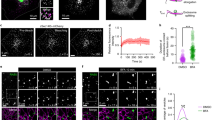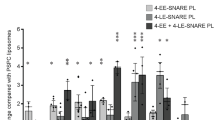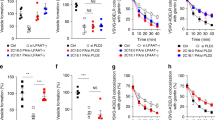Abstract
VESICULAR traffic in eukaryotic cells is characterized by two steps of membrane rearrangement: the formation of vesicles from donor membranes and their fusion with acceptor membranes. With respect to vesicle formation, several of the cytosolic proteins implicated in budding and fission have been identified. A feature common to all these proteins is that their targets, when known, are other proteins rather than lipids. Here we report, using a previously established cell-free system1,2derived from a neuroendocrine cell line, the purification of cytosolic factors that stimulate the formation of constitutive secretory vesicles and immature secretory granules from the trans-Golgi network. One such factor, referred to as CAST1, was identified as the α and β isoforms of the mammalian phosphatidylinositol transfer protein (Ptdlns-TP) (refs 3á¤-5). The yeast Ptdlns-TP, SEC14p (ref. 6), which has no sequence homo-logy to mammalian Ptdlns-TP (refs 7,8), was able to substitute for the mammalian Ptdlns-TP in secretory vesicle formation. Our results suggest a highly conserved role for phosphoinositides in vesicle formation.
This is a preview of subscription content, access via your institution
Access options
Subscribe to this journal
Receive 51 print issues and online access
$199.00 per year
only $3.90 per issue
Buy this article
- Purchase on Springer Link
- Instant access to full article PDF
Prices may be subject to local taxes which are calculated during checkout
Similar content being viewed by others
References
Tooze, S. A. & Huttner, W. B. Cell 60, 837–847 (1990).
Ohashi, M. & Huttner, W. B. J. biol. Chem. 269, 24897–24905 (1994).
Wirtz, K. W. A. A. Rev. Biochem. 60, 73–99 (1991).
Tanaka, S. & Hosaka, K. J. Biochem. Tokyo 115, 981–984 (1994).
de Vries, K. J. et al. Biochem. J. 310, 643–649 (1995).
Bankaitis, V. A., Aitken, J. R., Cleves, A. E. & Dowhan, W. Nature 347, 561–562 (1990).
Bankaitis, V. A., Malehorn, D. E., Emr, S. D. & Greene, R. J. Cell Biol. 108, 1271–1281 (1989).
Dickeson, S. K. et al. J. biol. Chem. 264, 16557–16564 (1989).
Tooze, S. A., Weiss, U. & Huttner, W. B. Nature 347, 207–208 (1990).
Snoek, G. T., de Wit, I. S., van Mourik, J. H. & Wirtz, K. W. J. Cell Biochem. 49, 339–348 (1992).
Niehrs, C. & Huttner, W. B. EMBO J. 9, 35–42 (1990).
Skinner, H. B., Alb, J. G. Jr, Whitters, E. A., Helmkamp, G. M. Jr & Bankaitis, V. A. EMBO J. 12, 4775–4784 (1993).
Franzusoff, A. & Schekman, R. EMBO J. 8, 2695–2702 (1989).
Cleves, A. E. et al. Cell 64, 789–800 (1991).
Hay, J. C. & Martin, T. F. Nature 366, 572–575 (1993).
Cunningham, E., Thomas, G. M. H., Ball, A., Hiles, I. & Cockcroft, S. Curr. Biol. 5, 775–783 (1995).
Hay, J. C. et al. Nature 374, 173–177 (1995).
Liscovitch, M. & Cantley, L. C. Cell 81, 659–662 (1995).
Beck, K. A. & Keen, J. H. J. biol. Chem. 266, 4442–4447 (1991).
Schu, P. V. et al. Science 260, 88–91 (1993).
Norris, F. A., Ungewickell, E. & Majerus, P. W. J. biol. Chem. 270, 214–217 (1995).
Ye, W., Ali, N., Bembenek, M. E., Shears, S. B. & Lafer, E. M. J. biol. Chem. 270, 1564–1568 (1995).
Musacchio, A., Gibson, T., Rice, P., Thompson, J. & Saraste, M. Trends biol. Sci. 18, 343–348 (1993).
Harlan, J. E., Hajduk, P. J., Yoon, H. S. & Fesik, S. W. Nature 371, 168–170 (1994).
Vater, C. A., Raymond, C. K., Ekena, K., Howald-Stevenson, I. & Stevens, T. H. J. Cell Biol. 119, 773–786 (1992).
Stenbeck, G. et al. EMBO J. 12, 2841–2845 (1993).
van den Akker, W. M. R., Westerman, J., Gadella T. W. J. Jr, Wirtz, K. W. A. & Snoek, G. T. FEBS Lett. 276, 123–126 (1990).
Geijtenbeek, T. B. et al. Biochim. biophys. Acta 1213, 309–318 (1994).
Jansen-Dürr, P. et al. Nucleic Acids Res. 20, 1243–1249 (1992).
Skinner, H. B. et al. Proc. natn. Acad. Sci. U. S. A. 92, 112–116 (1995).
Author information
Authors and Affiliations
Rights and permissions
About this article
Cite this article
Ohashi, M., de Vries, K., Frank, R. et al. A role for phosphatidylinositol transfer protein in secretory vesicle formation. Nature 377, 544–547 (1995). https://doi.org/10.1038/377544a0
Received:
Accepted:
Issue Date:
DOI: https://doi.org/10.1038/377544a0
This article is cited by
-
Restoration of PITPNA in Type 2 diabetic human islets reverses pancreatic beta-cell dysfunction
Nature Communications (2023)
-
Diacylglycerol kinase-α phosphorylation by Src on Y335 is required for activation, membrane recruitment and Hgf-induced cell motility
Oncogene (2008)
-
Phosphatidylinositol transfer proteins and cellular nanoreactors for lipid signaling
Nature Chemical Biology (2006)
-
The mesh hypothesis of Golgi dynamics
Nature Cell Biology (1999)
-
COPI-mediated protein and lipid sorting in the early secretory pathway
Protoplasma (1999)
Comments
By submitting a comment you agree to abide by our Terms and Community Guidelines. If you find something abusive or that does not comply with our terms or guidelines please flag it as inappropriate.



